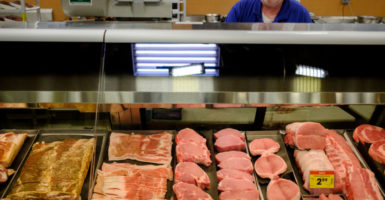Many Americans are rightfully concerned about the status of the country’s meat supply during the COVID-19 pandemic.
Unfortunately, there are no simple answers to help address those concerns, and the situation is constantly changing.
The following is a Q&A regarding the current status of the meat (including poultry) supply and provides a few recommendations that could help address any supply problems going forward.
>>> When can America reopen? The National Coronavirus Recovery Commission, a project of The Heritage Foundation, is gathering America’s top thinkers together to figure that out. Learn more here.
Q: In general, do we have a food shortage?
A: According to both the U.S. Department of Agriculture and the Food and Drug Administration, the U.S. isn’t facing a food shortage.
Even though Americans might be seeing empty grocery shelves, that is generally a logistics and inventory problem, not a reflection of food shortages.
The coronavirus has drastically disrupted the food supply chain. In fact, rapid changes to the demand for certain foods resulted in surpluses, rather than shortages.
Major customers for food, such as restaurants, hotels, and schools, all of a sudden were no longer food customers (or their demand was significantly reduced). Prior to the coronavirus, 54 cents out of every $1 spent on food was spent away from home.
Those surpluses are why farmers have reportedly been dumping commodities such as milk and produce. Commodities that were supposed to go to those customers no longer had a destination.
As for the current concerns regarding the meat supply, there is an additional—and more pressing—problem due to disruptions in meat slaughtering and packing facilities.
Q: Why are there concerns over the meat supply?
A: Some meat-processing plants are closing or reducing their operations due to coronavirus illnesses, affecting the beef, pork, and poultry industries. There has also been a reported 20 workers from meat-processing facilities who have died due to the coronavirus.
Major companies such as Smithfield Foods and Tyson Foods have been closing plants. Tyson Foods published a widely reported advertisement in several newspapers expressing serious concern about the meat supply.
One reported estimate asserts that pork slaughter capacity has been reduced by 25% and beef slaughter capacity by 10%.
Q: What does that mean for consumers?
A: There appears to be significant agreement among experts that there will be meat-supply disruptions, but that doesn’t mean meat won’t be available.
Within the next few weeks, it’s likely that some meat availability, though, will be reduced and prices will increase.
To simplify and expedite operations, some processing plants are expected to make changes to their product. Therefore, for example, it might be difficult to find boneless chicken breasts at the grocery store, whereas chicken drumsticks will be available.
If processing plants start to open back up, then these selection and price issues will be reduced. If they don’t open up, and more processing facilities are closed, then the problem could get worse.
This is a fluid situation that warrants close attention. Consumers can also help mitigate any problems by not hoarding meat and looking to different sources of protein beyond beef, pork, and poultry.
Q: Why are farmers euthanizing animals if there are concerns with the supply of meat?
A: As with the dairy farmers who dumped their milk, livestock and poultry farmers are faced with the problem of not having a destination for their animals. Due to space limitations and costs, they can’t keep them. That has led to very unfortunate problems requiring animals to be euthanized.
Q: Why don’t processing plants simply hire new employees to replace those who are sick?
A: The employees are not easily replaced because there is a level of specialized knowledge required.
Q: What should be done to address the closing of meat-processing plants?
A: The following are just a few recommendations.
The top priority needs to be creating a work environment that is safe for employees. Unlike most other employees on the food front lines, workers at processing facilities work very closely together, making it difficult to address the coronavirus problem.
The employees can be spread further apart, but that would reduce the meat supply due to lower processing speeds, although that may need to be part of any solution.
When distributing personal protective equipment and making testing available, the federal government and states need to work together and prioritize workers at these plants.
The meat-processing companies should be doing what they can as well to secure personal protective equipment and testing.
They also need to adapt and make changes to protect their workers, including being in compliance with the new guidance from the Centers for Disease Control and Prevention and the Occupational Safety and Health Administration regarding workplace safety at processing facilities.
At the same time, there’s a need for liability protections for companies that do take appropriate steps to protect workers.
On Tuesday, President Donald Trump issued an executive order that expresses the administration’s concern about the current situation and is designed to keep processing plants open.
The Department of Labor also issued a statement regarding its enforcement policy that appears to minimize liability if proper actions are taken. Ideally, Congress would pass legislation to provide the necessary liability protection.
All of that said, the food supply chain, from farmers to grocery stores, is remarkably resilient and innovative. While there’s a current challenge facing the meat industry, there’s little reason to think the food supply chain won’t again rise up to find solutions.
Soon enough, this specific challenge will be solved, just like the coronavirus that has caused this pandemic.

























